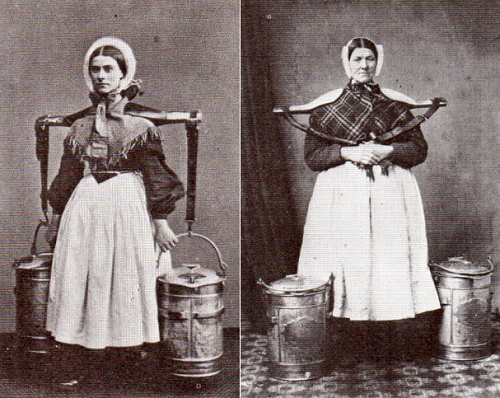Mar 19 2016 - Explore Bec Banhams board Victorian Working ClassLower Class Clothing 1840-1860 followed by 181 people on Pinterest. The author has graciously shared with readers of the Victorian Web this passage from the second edition of her Fashion in Costume 1200-2000 2000 published by A C Black Publishers Ltd which retains copyright.

Early 1870s History Victorian Life Old Photos
The sack coat became fashionable during the 1850s for leisure activities.
. They normally wore mole-skin trousers and donkey jacket- style short coats which I think were known as pea jackets or pilot jackets in those days. The working class comprises those engaged in manual-labour occupations or industrial work who are remunerated via waged or salaried contracts. The neckties would have been worn as sweat rags particularly during the great days of railway construction during the 1840s and 1850s.
High fastening and tight fitting frock coats were also very fashionable. During 1860s mens fashion underwent a change. The document has moved here.
Masculine styles began to originate more in London while female fashions originated almost exclusively in Paris. All original front hook eye closure with white cotton inner bodice with deep front stays. The bowler hat was invented around 1850 but was generally seen as a working class hat while top-hats were favoured by the upper classes.
The hoop was popular almost universally and was worn by ladies maids the middle class and. To protect your hair from dirt add a freshly laundered day cap. Tradition and the working class 18501950.
Apron Wear an apron to. However the waistcoats seem to have been universal. By 1855 the cage crinoline or hoop had swayed on to the scene.
The aristocratic class normally wore the top-hats while the bowler hats were worn by the working-class. Tradition and the Working Class 18501950 The Harvard community has made this article openly available. Please share how this access benefits you.
Though a new style called the sack coat a thigh-length loosely fitted jacket became popular. International Labor and Working Class History 42. 1850 1859 Fashion History Timeline Fashion magazines also became popular during this time period.
1850s fashion in Western and Western-influenced clothing is characterized by an increase in the width of womens skirts supported by crinolines or hoops the mass production of sewing machines and the beginnings of dress reform. 1860s cocoa. As found with the entire center front with vertical tear other smaller tears as seen with many old mends and scattered holes.
Introduced in 1856 the hoop skirt greatly altered the silhouette of the womans wardrobe. WORKING-CLASS DRESSFor much of the period between the eighteenth century and the present most people in western countries could be characterized as working class. The typical skirt of the 1850s was still dome-shaped.
Source for information on Working-Class Dress. Towards the end of the decade the waistline lengthened and sleeves began to fit smoothly at the shoulder Byrde 95. Many occupations and styles of living are encompassed ranging from independent skilled artisans in regular work to unskilled laborers or the unemployed.
Wide collars of lace crochet or tatting fell flat across the shoulders. The hair is worn in a simple bun at the nape of the neck higher in the 1840s and lower in the 1850s and 1860s. Rose Bertin 1744 - 1813 was the first internationally known milliner who worked out of Le Grande Moghul in Paris making hats for the nobility and upper class.
Members of the working class rely exclusively upon earnings from wage labour. Skirts expanded to their maximum size. In 1800 working-class people wore linen underwear men wore woollen outer clothing and women wore cotton linen and woollen dresses.
Ad Shop Top-Quality Authentic Styles Enjoy Great Prices Service Delivery. Boys wore dresses until they were breeched. Milliners created hats for the elite as well as the middle class.
By 1850 the cotton linen and woollen trades were fully mechanised in England. Working-class occupations include blue-collar jobs and most pink-collar jobs. For example Ivy Pinchbecks Women Workers and the Industrial Revolution 1750-1850 1930 and with Margaret Hewitt Children in English Society 1969 certainly foreshadowed the concerns of a later generation of social historians yet took women and children rather than the working class as their subject.
Coats nipped in at the waist their skirts flared and most notably sleeves featured a marked fullness that puffed at the shoulder echoing the gigot sleeves of female fashions Fig. Breeches symbolized the upper class and the trousers were worn by the working class. By 1850 men wore shirts with high collars and a bow.
Hand-spinning had largely died out which prevented industrious families from producing their own textiles to reduce costs. Thus according to more inclusive definitions the category can. The neckties were broader and were to be tied in a bow or looped into a loose knot and tied with a stickpin.
Paris remained the arbiter of fashion. It gave relief from the weight of numerous petticoats and from the plethora of undergarments that needed to be washed. Im wearing a plain cotton day cap which is easy to iron.
Your story matters Citation Cohen Lizabeth. During the early 1850s the common daydress had a very short underarm seam a shallow rounded dip at the waistfront and a soft and full fan bosom. Readers wishing to obtain the book can e-mail the following address.
Women were delighted to wear the cage. See more ideas about historical fashion historical clothing historical dresses. Skirt is unlined turned back cuffs with ruffle and double ruffle at top of sleeves worn cuffs.

Stitching The Fashions Of The 19th Century Who Dressed The 19th Century Elite

1840 1849 Fashion History Timeline

Working Class Victorian Life Witness2fashion

200 C19th Plainer Workdresses Female Clothing Ideas Historical Clothing Fashion 1800 Period Outfit



0 comments
Post a Comment